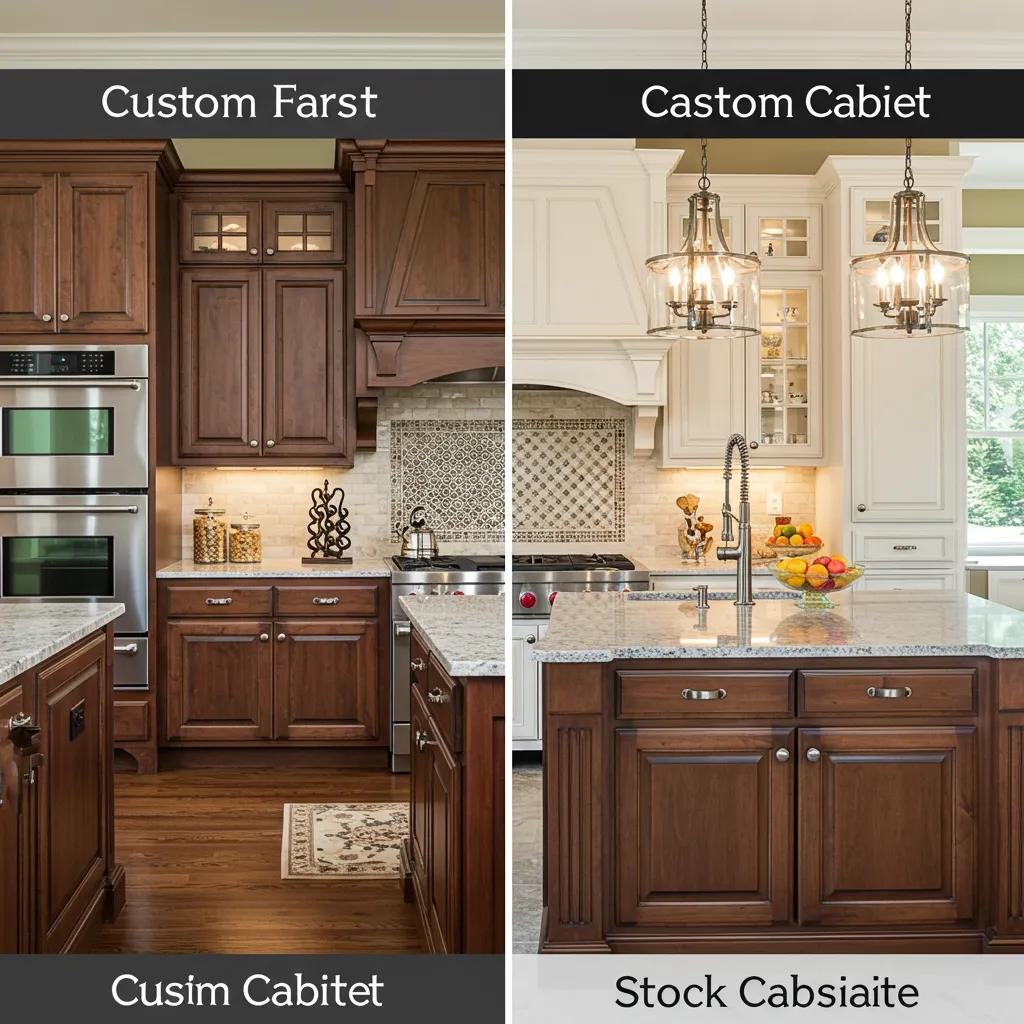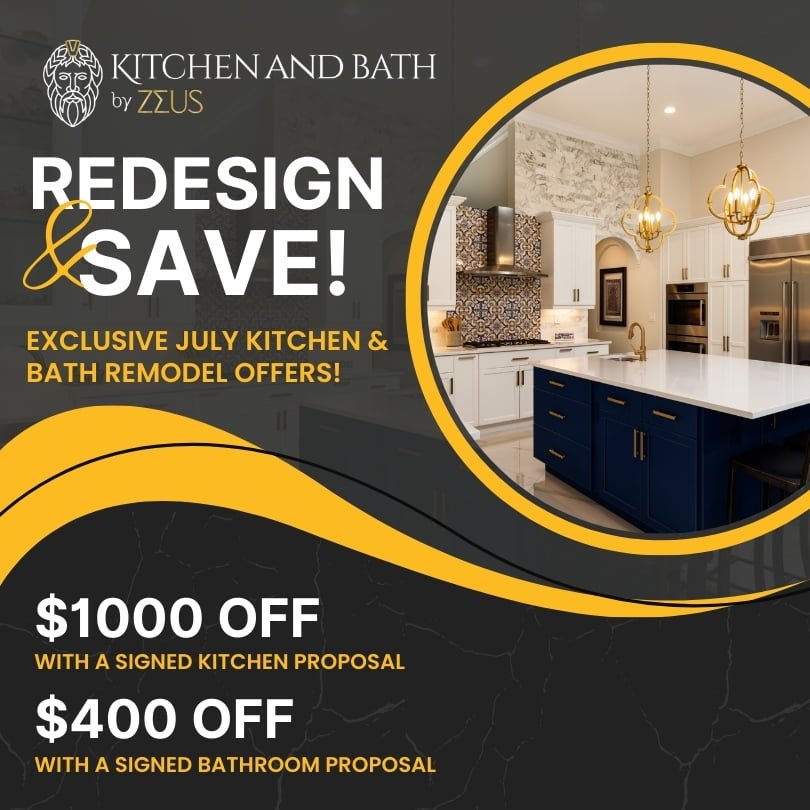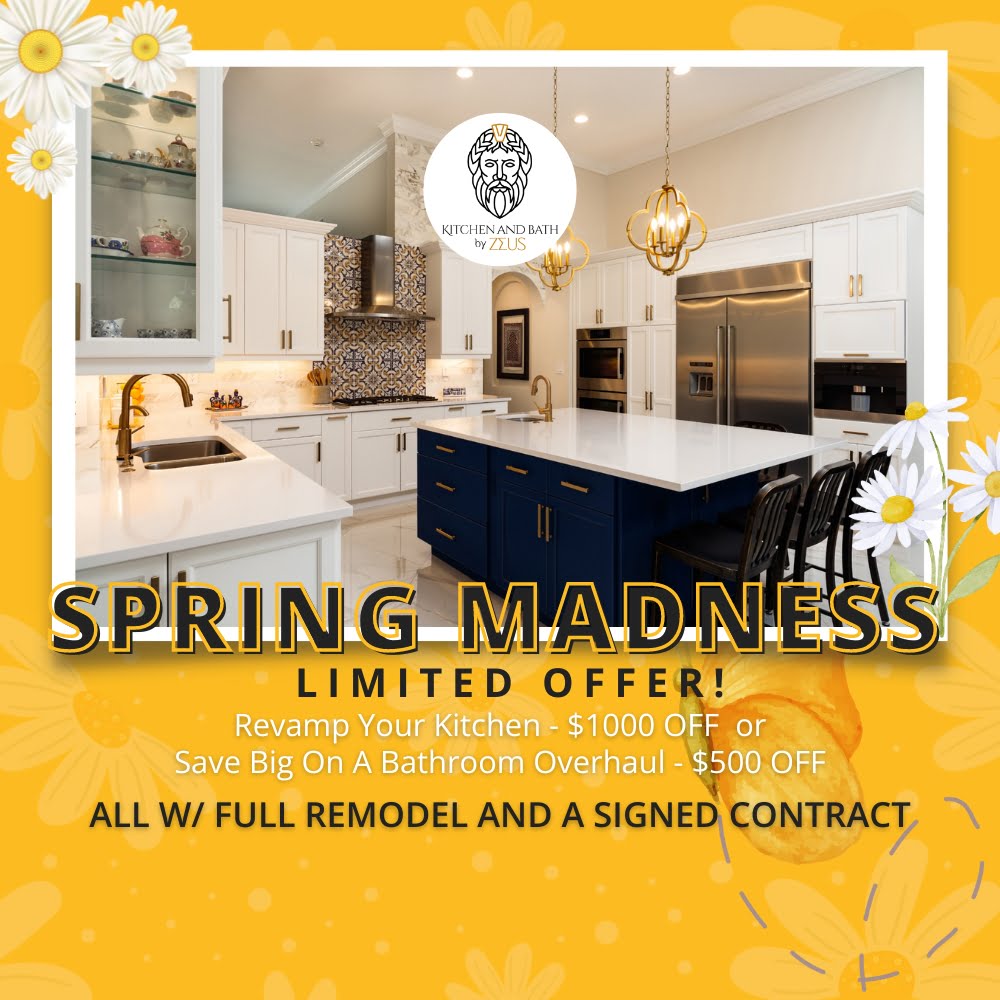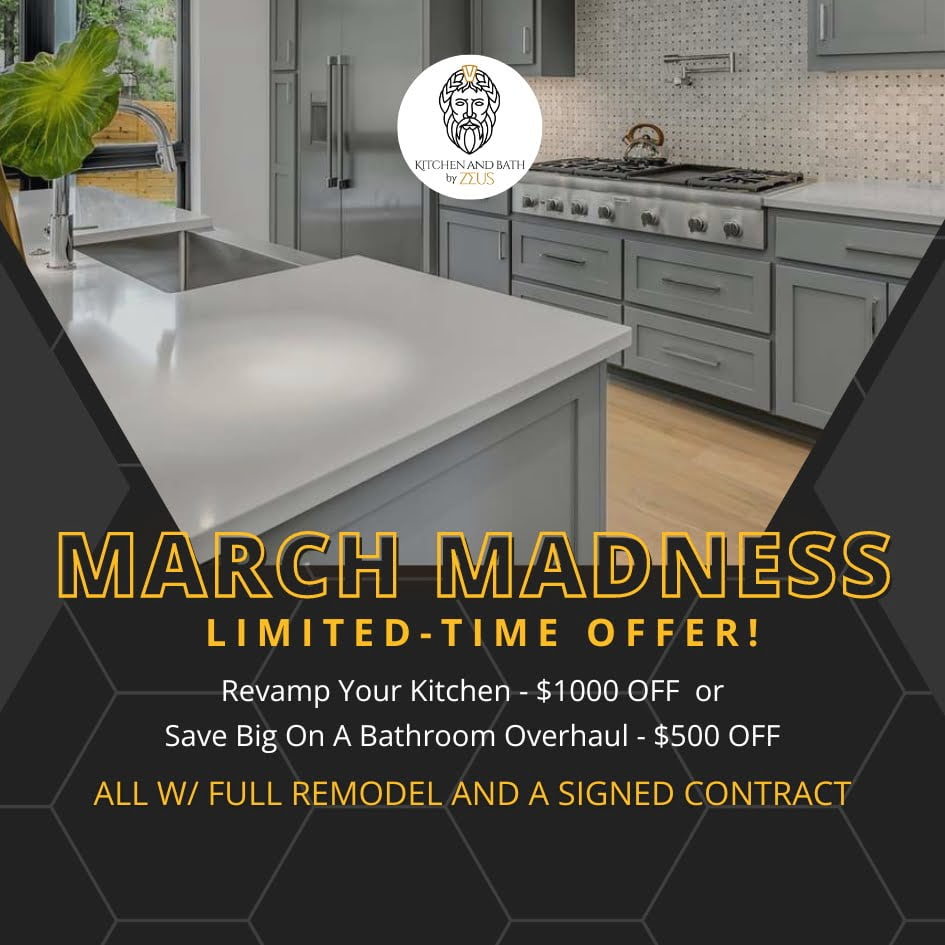When planning a kitchen or bathroom remodel in Sandy Springs, one of the most impactful decisions you’ll make is whether to invest in custom cabinetry vs. stock cabinets. Custom cabinets offer unparalleled design flexibility, premium materials, and a perfect fit for your unique space, while stock cabinets provide a budget-friendly, quicker solution with a range of standard styles. In this guide, we’ll compare the key differences—from cost and timeline to quality and personalization—so you can determine the best choice for your home’s aesthetic, functional needs, and long-term value.
Custom Cabinetry vs. Stock Cabinets: Style, Value & Function
What Are The Key Differences Between Custom, Stock, And Semi-Custom Cabinets?
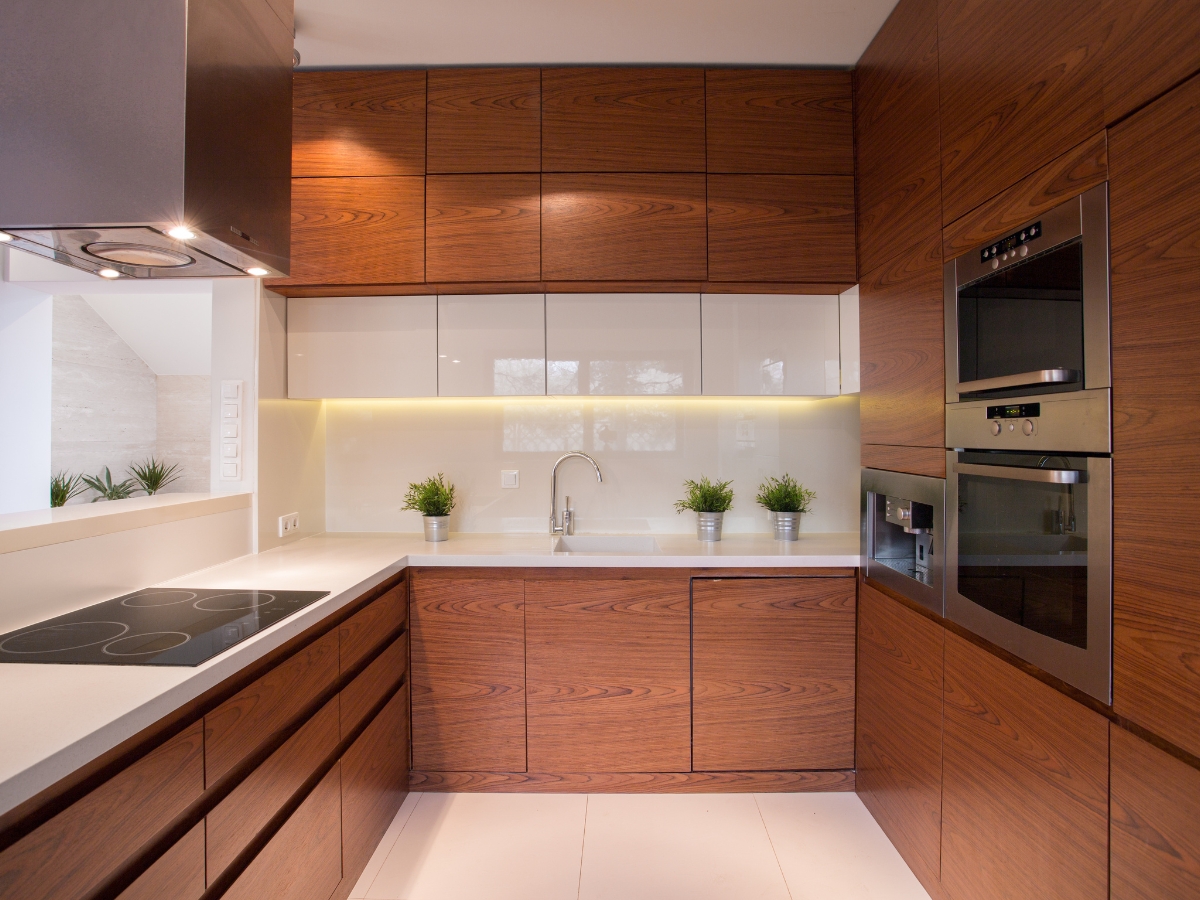
Choosing cabinets sets the tone for how your kitchen works and looks. Stock lines are pre-made in fixed sizes, semi-custom adds targeted flexibility, and full custom is built to your exact measurements. Understanding how each option handles sizing, materials, finishes, and lead times will help you match your budget and timeline without sacrificing function.
What Defines Stock Cabinets And Their Pros And Cons?
Stock cabinets are produced in standard widths and heights, then shipped quickly. The big win is speed and price. In many Sandy Springs projects, stock runs 30–50% less than custom and can arrive within about a week, which keeps remodels moving. You get consistent factory finishes and simple choices that are easy to coordinate.
Limits do exist. Because the sizes are fixed, fillers are often needed in tricky corners or around appliances. Interior options are basic, and boxes may be built with particleboard or MDF that does not love repeated moisture exposure. If your space has odd angles, soffits, or tall ceilings, fitting stock neatly can take extra planning.
How Does Custom Cabinetry Offer Design Flexibility And Quality?
Custom cabinetry is made to order for your room. Every cabinet is measured, sized, and assembled to fit walls, islands, and ceiling heights with minimal gaps. You can select hardwood doors, plywood boxes, dovetail drawers, and durable finishes that stand up to heavy use. Storage can be tailored with pull-outs, tray dividers, spice pull-outs, toe-kick drawers, and integrated lighting so the layout supports how you cook.
Customization also shows in the details: matching grain on wide panels, specialty hoods, or built-in banquette seating. The tradeoff is cost and time. Custom typically carries the highest price and a longer lead time, but it delivers a precise fit and long service life that many homeowners value.
What Is The Role Of Semi-Custom Cabinets As A Middle Ground?
Semi-custom blends factory efficiency with measured flexibility. You start with a catalog line, then tweak dimensions, increase cabinet depths, add extended heights, choose from more door styles, and upgrade interiors. Pricing usually lands between stock and custom, making it a practical path when you want a cleaner fit and better materials without going fully bespoke. Lead times stretch beyond stock but remain manageable for most remodel schedules.
Which Option Fits Your Kitchen And Budget?
Begin with your constraints. If the project is cost driven and you want a fast install, stock cabinets are hard to beat. If your kitchen has challenging dimensions, or you want premium materials and specialized storage, custom will solve problems and elevate daily use. When you need something in between, semi-custom often delivers the right mix of fit, features, and value.
Think about how long you plan to live in the home, the level of wear your kitchen sees, and the look you are targeting. Light family use might do well with stock plus a few thoughtful accessories. A busy household that cooks daily may appreciate custom-grade boxes, soft-close hardware, and durable finishes. If you are comparing custom cabinetry vs. stock cabinets, look beyond upfront price and weigh installation labor, fillers, storage efficiency, and future resale.
The best choice is the one that fits your space with minimal compromise, keeps essentials within easy reach, and holds up to years of meals and gatherings. With a clear plan, you can pair the right cabinet class with the right layout and end up with a kitchen that looks sharp and works even better.
How Do Cost And Investment Compare For Custom And Stock Cabinets In Sandy Springs?
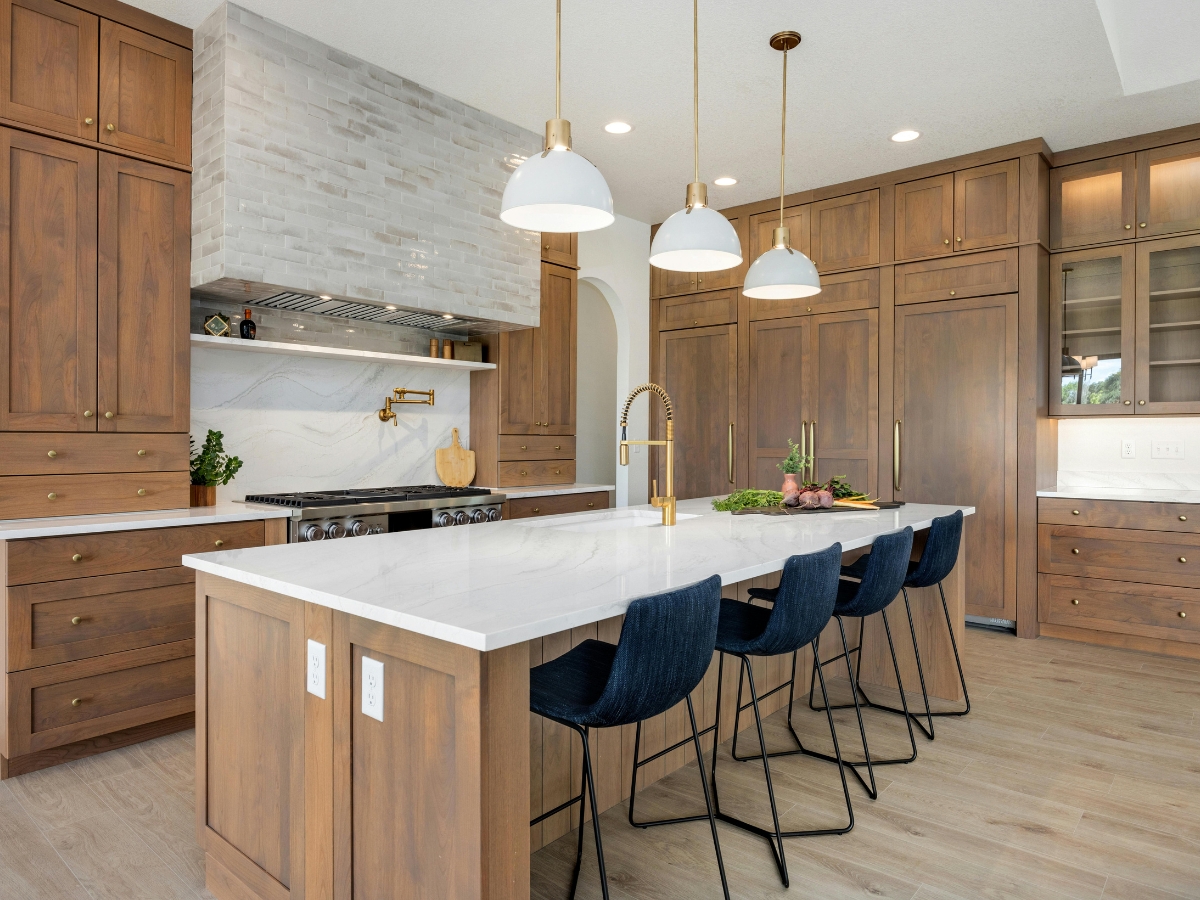
Cabinet budgets hinge on materials, construction, and lead time. Stock lines are factory made in fixed sizes, semi-custom adds selective tweaks, and full custom is built to fit your exact layout. If you are weighing custom cabinetry vs. stock cabinets, the real question is how much precision, durability, and storage efficiency you need for the price.
What Is The Typical Cost Difference Between Custom And Stock Cabinets?
In Sandy Springs, stock cabinets usually run about $100 to $200 per linear foot and can arrive in 1 to 2 weeks. Semi-custom averages $150 to $350 per linear foot with a 3 to 6 week lead time. Custom work typically ranges from $250 to $750 per linear foot and may take 6 to 12 weeks. These ranges reflect box construction, finish type, hardware quality, and any specialty pieces like tall pantries or built-in organizers. While stock keeps upfront costs low, it often relies on fillers to close gaps in nonstandard spaces. Custom minimizes fillers and maximizes every inch, which can reduce wasted storage and improve your daily workflow.
How Does Custom Cabinetry Impact Home Value And ROI?
Custom cabinetry can lift resale appeal by showcasing premium construction, tailored organization, and a cohesive design that feels built in rather than added on. In the Atlanta market, thoughtful kitchen upgrades with high-quality cabinets often see a 70 to 80 percent return, especially when paired with durable countertops and updated lighting. Longevity matters too. Plywood boxes, hardwood doors, and dovetail drawers resist wear better than lower-grade materials, which helps the kitchen look newer for longer and reduces replacement or repair costs over time.
When Do Stock Or Semi-Custom Make Better Financial Sense?
Stock cabinets make sense for straightforward layouts, secondary spaces, or timelines that demand quick delivery. They also suit projects where the priority is a clean refresh at a lower price point. Semi-custom is a smart compromise if you need better fit, more finish options, or upgraded interiors without going all the way to bespoke. It handles small dimension changes, extended heights, and deeper boxes that improve storage efficiency at a moderate premium.
How Should You Plan A Realistic Cabinet Budget?
Start by confirming linear footage and the cabinet list so you can compare quotes fairly. Ask for the box material, door construction, finish system, and hardware brand to be specified, since these details drive both price and performance. Include installation, trim carpentry, crown or light rail, panels for appliance ends, and any required electrical or plumbing adjustments. Lead time also affects cost if you need temporary storage or phased scheduling, so align ordering and delivery with your construction calendar.
What’s The Bottom Line For Sandy Springs Homes?
Choose stock when speed and cost control are the top goals for a standard layout. Choose semi-custom when you want stronger fit, more choices, and better interiors without full bespoke pricing. Choose custom when the space is complex, storage is a priority, or long-term value matters most. Matching the cabinet class to the way you cook, entertain, and live will deliver the best balance of upfront cost, daily function, and future resale.
How Do Design Flexibility and Material Quality Affect Your Cabinet Choice?
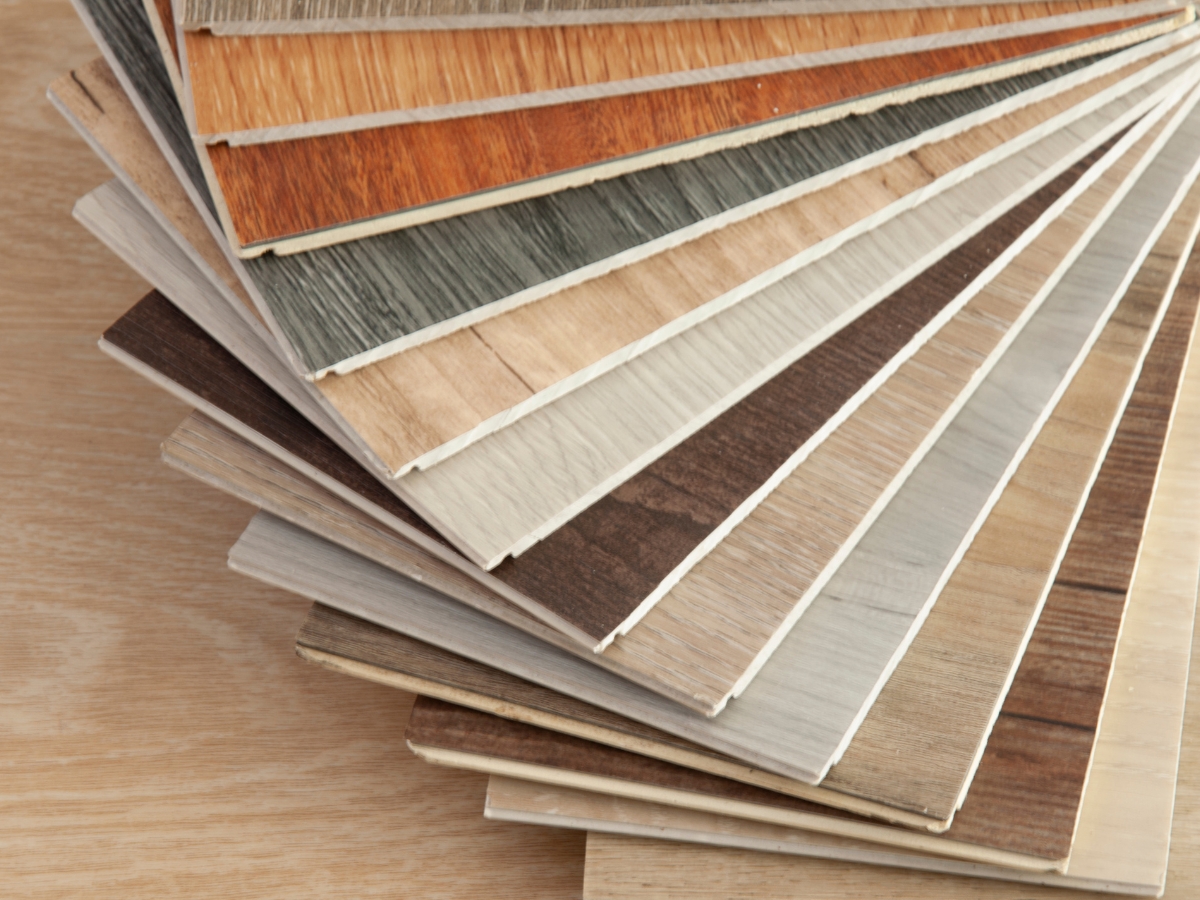
Choosing between custom cabinetry vs. stock cabinets comes down to two things that matter every day in a kitchen or bath: how well the design fits your space and how long the materials hold up. The right choice should solve layout challenges, support your storage habits, and stand up to moisture, heat, and frequent cleaning.
What Design Options Are Available With Custom Cabinets?
Custom cabinets are built to the room, not the other way around. That means exact sizing for tricky corners, ceiling-height runs, and tight alcoves. You can match door styles and finishes to your home’s architecture, from simple shaker to modern flat panel or inset frames. Designers can plan islands with seating, tuck in tray dividers above the oven, add spice pullouts beside the range, and hide small appliances behind pocket or lift-up doors so counters stay clear. Interior fittings are tailored too, including deep drawers for pots, roll-out trays at base level, and built-in recycling stations. The result is a layout that looks seamless and works the way you cook and store.
What Materials Are Used In Custom Vs. Stock Cabinets And How Do They Affect Durability?
Material choice drives lifespan. Many custom lines use furniture-grade plywood boxes with hardwood face frames and doors. Plywood resists swelling and holds fasteners well, which keeps cabinets square over time. Solid hardwood doors can be refinished and repaired. Stock cabinets often rely on particleboard or MDF for boxes and shelves. These options keep costs down and finish smoothly, but they are more vulnerable to moisture and heavy loads. In kitchens with busy traffic or in bathrooms with daily steam, moisture-resistant plywood boxes and sealed finishes provide better long-term stability. Expect well-made plywood and hardwood builds to last decades, while entry-level composites usually have a shorter service life.
How Do Construction Details And Hardware Influence Performance?
Look closely at how cabinets are put together. Dovetail drawer boxes, full-extension soft-close slides, and soft-close concealed hinges improve strength and usability. A thicker cabinet back supports wall mounting and keeps boxes rigid. Face frames, when specified, add structure and help doors stay aligned. On frameless European-style boxes, thicker sides and quality edge banding prevent racking and chipping. Factory finishes vary, but multi-step catalyzed or high-performance waterborne systems resist staining and clean easily. These details affect how quietly doors close, how smoothly drawers glide under heavy pans, and how well everything stays aligned after years of use.
When Do Stock Or Semi-Custom Make Sense?
Stock cabinets are a practical fit for straightforward rooms, rental refreshes, and tight timelines. You get reliable sizing, a handful of popular finishes, and quick delivery. Semi-custom strikes a balance by offering size tweaks, added depth or height, and more finishes without the cost of full bespoke work. It is a smart choice when you need a better fit and features but do not require every dimension to be built from scratch.
Which Option Fits Your Space And Budget?
If your room has odd dimensions, you want an uninterrupted crown to the ceiling, or you need specialized storage, custom delivers the best result and the cleanest look. If your layout is standard and the priority is cost and speed, stock is hard to beat. For most homes, semi-custom provides strong value with enough flexibility to solve common layout issues. Whichever route you choose, confirm box material, door construction, finish type, and hardware in the proposal. Those specs tell you how the cabinets will look and perform not only on day one, but years down the line.
What Should Sandy Springs Homeowners Consider About Installation And Project Timelines?
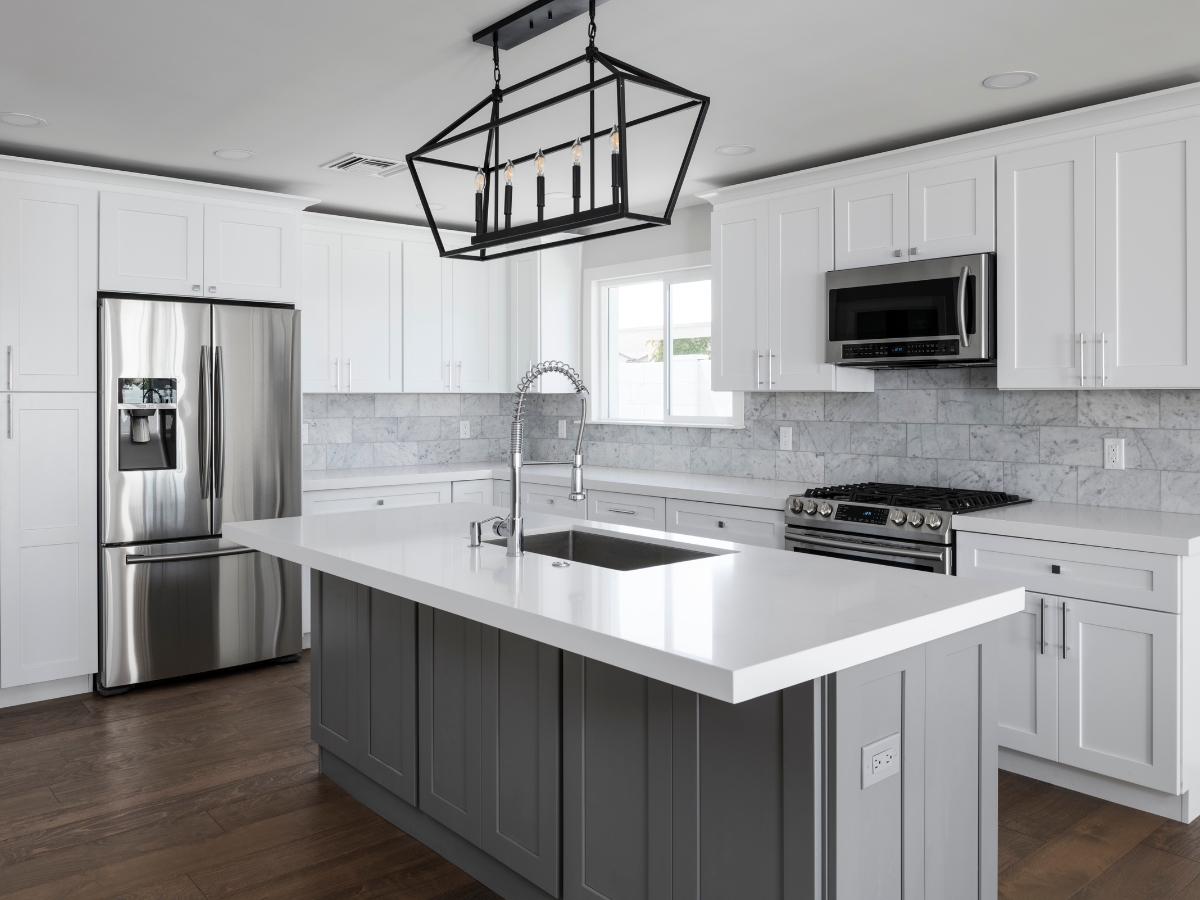
Installing new cabinets touches several trades, so timing matters as much as style. Your schedule needs to account for cabinet delivery, on-site installation, countertop templating and fabrication, appliance hookups, flooring, and final paint. Weather is rarely a factor indoors, but permit review, inspections, and material lead times can affect start dates. Plan backward from any must-hit milestone, like a family event, and build in a small buffer so minor hiccups do not snowball.
How Long Does Custom Cabinet Installation Take Compared To Stock Cabinets?
When comparing custom cabinetry vs. stock cabinets, the timeline differs in two phases: production and installation. Stock cabinets are prebuilt in standard sizes, so once they arrive, a straightforward kitchen can be set in place in about 1 day. Semi-custom options usually arrive quicker than fully custom and often need 1 to 2 weeks from delivery to finish, because modest size tweaks and added accessories require more fitting. Custom cabinetry is made to exact measurements and typically takes 2 to 4 days on-site for leveling, scribing to walls and ceilings, and precise hardware alignment. Complex rooms, tall ceilings, or built-in panels for appliances can add a day.
What Steps Are Involved In A Professional Custom Cabinet Installation?
A good installer starts with verification measurements to confirm walls, floors, and ceilings match the final shop drawings. Base cabinets are set and shimmed to a laser line so countertops sit perfectly level. Tall and wall units follow, anchored to studs with the correct fasteners and backed by ledger support where needed. Filler strips and crown are scribed for tight seams, then doors and drawers are adjusted for even reveals. Hardware is laid out with a template to keep spacing consistent. Before sign-off, the crew protects finished surfaces and confirms doors close softly, drawers glide fully, and panels align with any appliance fronts.
How Do Timelines Affect Countertops, Flooring, And Appliances?
Countertop fabricators cannot template until base cabinets are fully secured and level, so any delay in cabinet day pushes back stone lead times. Most fabricators return in about 5 to 10 business days for installation after templating, longer for specialty edges or large slabs. If new flooring is part of the project, sequence it with your contractor. Floating floors often go in before cabinets to avoid cut patches, while nailed hardwood may be installed first and finished later. Appliances are last. Set the refrigerator and range after countertops and plumbing are complete to prevent damage and to ensure clearances are correct.
How Can Homeowners Reduce Delays And Keep Projects On Track?
Lock decisions early. Finalize door style, finish, interior accessories, and appliance specs before cabinets go to production so drawings do not require revisions. Clear the room the day before install, including counters, wall art, and baseboards the crew plans to replace. Confirm electrical and plumbing rough-ins match the plan so a pull-out trash or sink base is not competing for the same space. Keep a punch-list and address small items quickly while the team is on-site. A short daily check-in with your installer keeps everyone aligned and helps catch issues while they are easy to fix.
What If Your Project Has An Unusual Layout Or a Tight Deadline?
Irregular rooms, out-of-plumb walls, and built-in panel appliances favor custom or semi-custom because they allow made-to-fit parts and reduce filler. If timing is tight, consider a hybrid: stock boxes for straight runs and a few made-to-order fillers, panels, or a custom hood to finish the look. With a clear plan and realistic sequencing, you can hit your deadline without sacrificing fit, finish, or function.
Why Choose Kitchen And Bath By Zeus For Your Custom Or Stock Cabinet Needs In Sandy Springs?
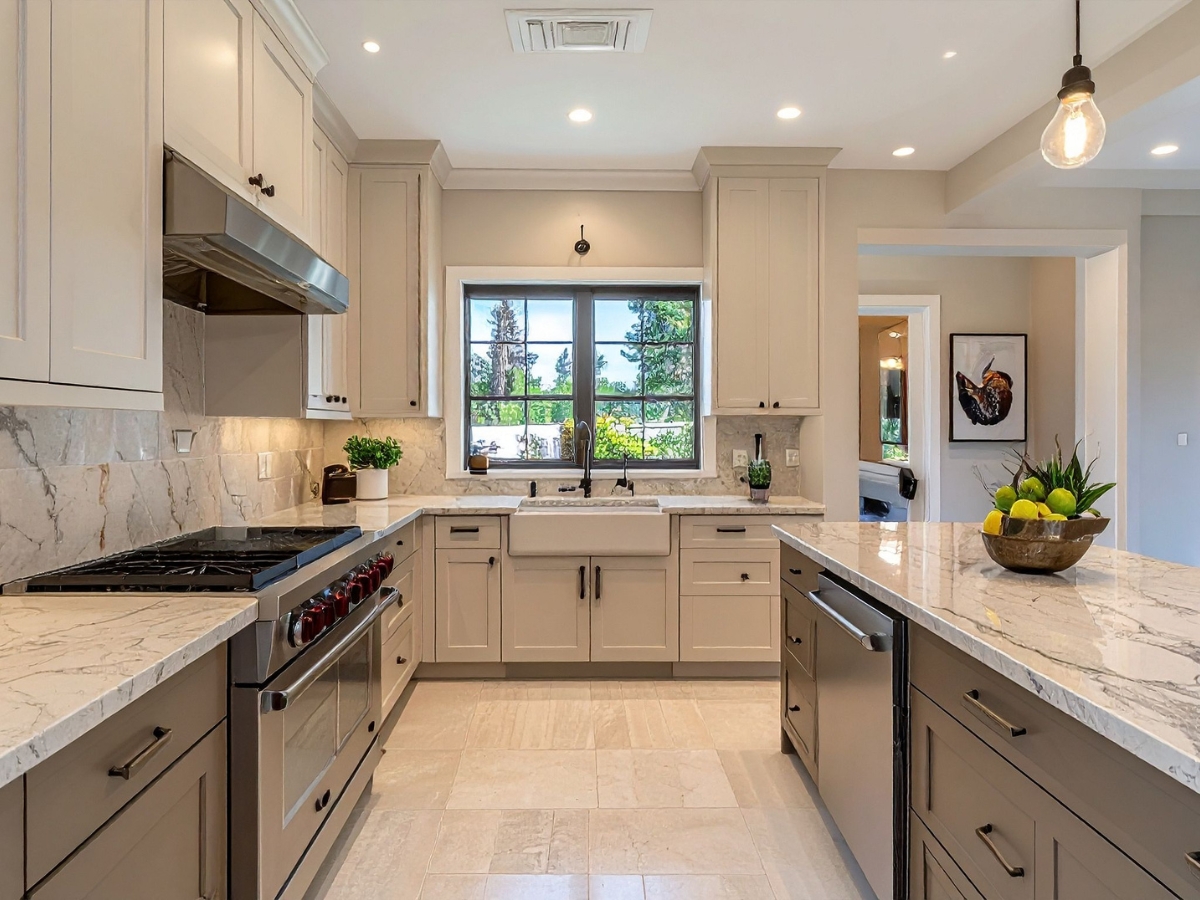
Choosing cabinets is more than picking a door style. It is a planning exercise that affects workflow, storage, lighting, and long-term upkeep. Kitchen and Bath by Zeus starts with how you live and cook, then shapes the layout around that routine. If you are comparing custom cabinetry vs. stock cabinets, our team lays out clear options for fit, finish, and budget so you understand where customization delivers real value and where a standard size will do the job just as well. Precise field measurements and scaled drawings reduce surprises, while sample finishes shown in your home’s lighting help you select a tone that ties the space together.
How Does Kitchen And Bath By Zeus Deliver Personalized Cabinet Solutions?
Personalization begins with a space audit. Designers verify wall plumb, ceiling heights, and appliance clearances, then map storage zones for prep, cooking, serving, and cleaning. That plan guides decisions on drawer depths, pull-outs, tray dividers, and corner solutions that prevent dead space. Material advice is practical, too.
In moisture-prone rooms, we recommend plywood boxes and durable finishes that handle steam and daily wipe-downs. For busy kitchens, soft-close hardware and full-extension glides improve access and hold up to repeated use. Lighting integration is addressed early, so under-cabinet and in-cabinet fixtures have routed channels and hidden power, not add-ons after countertops are in. The result is a cabinet package that looks cohesive and functions smoothly from day one.
What Do Local Clients Appreciate About Their Cabinet Projects?
Homeowners tend to value steady communication and jobsite discipline. That means a clear schedule, daily check-ins, and clean work areas that respect occupied homes. Installers arrive with shop drawings that match verified measurements, then level bases to a laser line so stone templating goes fast and accurately. Walls that are out of square are scribed for tight seams rather than filled with wide spacers.
Doors and drawers are adjusted for even reveals, and panels align with appliance fronts for a built-in look. When the space calls for it, mixed solutions are used smartly: stock boxes in straight runs, semi-custom for height tweaks, and a few fully custom pieces for tall ceilings, hutches, or a paneled hood. That balance controls cost without giving up fit or function.
How Do We Help You Navigate Budget, Schedule, And Finish Choices?
Budget transparency comes from itemized proposals that separate boxes, fronts, hardware, accessories, and installation labor. You can see exactly what each upgrade adds and decide where to invest. Timeline planning covers the full sequence: cabinet install, stone templating, countertop set, plumbing reconnects, backsplash, and final paint.
Because countertops cannot be templated until bases are secured, keeping the cabinet day on track protects the rest of the schedule. Finish guidance stays practical. Lighter stains hide dust and small scuffs, while deeper tones ground modern spaces but may need more frequent wipe-downs. Sheen matters as well. Satin and matte conceal wear better than high gloss in busy households.
What Kind Of Results Should You Expect After Installation?
Expect a kitchen or bath that feels organized and calm. Drawers open fully, tray dividers hold pans upright, spices sit at eye level, and trash pull-outs clear plumbing traps because the layout accounted for them early. Doors close softly, shelves stay square, and lighting lands where you prep and plate. Good cabinetry looks great on day one, but great cabinetry still feels effortless on day 1,000 because it was designed for how the space is actually used.
Conclusion
Choosing between custom cabinetry and stock cabinets ultimately depends on your Sandy Springs home’s unique layout, your personal style, and your long-term vision for the space. While stock options offer convenience, custom cabinetry delivers unparalleled craftsmanship, a perfect fit, and lasting value. At Kitchen and Bath by Zeus, we guide you through this important decision, creating beautiful, functional kitchen spaces that reflect your taste and enhance your daily life. Ready to design your dream kitchen or bath? Call 404-602-2668 or fill out our online form to schedule your free consultation today. Let’s build a space that’s uniquely you.


